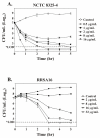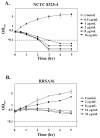Generation of ramoplanin-resistant Staphylococcus aureus
- PMID: 20659164
- PMCID: PMC3596103
- DOI: 10.1111/j.1574-6968.2010.02051.x
Generation of ramoplanin-resistant Staphylococcus aureus
Abstract
Ramoplanin is a lipoglycodepsipeptide antimicrobial active against clinically important Gram-positive bacteria including methicillin-resistant Staphylococcus aureus. To proactively examine ramoplanin resistance, we subjected S. aureus NCTC 8325-4 to serial passage in the presence of increasing concentrations of ramoplanin, generating the markedly resistant strain RRSA16. Susceptibility testing of RRSA16 revealed the unanticipated acquisition of cross-resistance to vancomycin and nisin. RRSA16 displayed phenotypes, including a thickened cell wall and reduced susceptibility to Triton X-100-induced autolysis, which are associated with vancomycin intermediate-resistant S. aureus strains. Passage of RRSA16 for 18 days in a drug-free medium yielded strain R16-18d with restored antibiotic susceptibility. The RRSA16 isolate may be used to identify the genetic and biochemical basis for ramoplanin resistance and to further our understanding of the evolution of antibiotic cross-resistance mechanisms in S. aureus.
Figures




Similar articles
-
Ramoplanin at bactericidal concentrations induces bacterial membrane depolarization in Staphylococcus aureus.Antimicrob Agents Chemother. 2014 Nov;58(11):6819-27. doi: 10.1128/AAC.00061-14. Epub 2014 Sep 2. Antimicrob Agents Chemother. 2014. PMID: 25182650 Free PMC article.
-
Nisin, alone and combined with peptidoglycan-modulating antibiotics: activity against methicillin-resistant Staphylococcus aureus and vancomycin-resistant enterococci.J Antimicrob Chemother. 2002 Nov;50(5):731-4. doi: 10.1093/jac/dkf190. J Antimicrob Chemother. 2002. PMID: 12407132
-
Comparative in-vitro activity of vancomycin, teicoplanin, ramoplanin (formerly A16686), paldimycin, DuP 721 and DuP 105 against methicillin and gentamicin resistant Staphylococcus aureus.J Antimicrob Chemother. 1989 Apr;23(4):517-25. doi: 10.1093/jac/23.4.517. J Antimicrob Chemother. 1989. PMID: 2526111
-
Chemistry and biology of the ramoplanin family of peptide antibiotics.Biopolymers. 2002;66(4):261-84. doi: 10.1002/bip.10296. Biopolymers. 2002. PMID: 12491539 Review.
-
Ramoplanin: a topical lipoglycodepsipeptide antibacterial agent.Expert Rev Anti Infect Ther. 2006 Dec;4(6):939-45. doi: 10.1586/14787210.4.6.939. Expert Rev Anti Infect Ther. 2006. PMID: 17181409 Review.
Cited by
-
Antimicrobial Resistance Phenotype of Staphylococcus aureus and Escherichia coli Isolates Obtained from Meat in the Formal and Informal Sectors in South Africa.Biomed Res Int. 2020 Sep 19;2020:3979482. doi: 10.1155/2020/3979482. eCollection 2020. Biomed Res Int. 2020. PMID: 33015163 Free PMC article.
-
Novel formulations for antimicrobial peptides.Int J Mol Sci. 2014 Oct 9;15(10):18040-83. doi: 10.3390/ijms151018040. Int J Mol Sci. 2014. PMID: 25302615 Free PMC article. Review.
-
Bacterial cell surface deformation under external loading.mBio. 2012 Dec 18;3(6):e00378-12. doi: 10.1128/mBio.00378-12. mBio. 2012. PMID: 23249811 Free PMC article.
-
An extensively validated whole-cell biosensor for specific, sensitive and high-throughput detection of antibacterial inhibitors targeting cell-wall biosynthesis.J Antimicrob Chemother. 2023 Mar 2;78(3):646-655. doi: 10.1093/jac/dkac429. J Antimicrob Chemother. 2023. PMID: 36626387 Free PMC article.
-
Production of Ramoplanin and Ramoplanin Analogs by Actinomycetes.Front Microbiol. 2017 Mar 6;8:343. doi: 10.3389/fmicb.2017.00343. eCollection 2017. Front Microbiol. 2017. PMID: 28321210 Free PMC article.
References
-
- Ayliffe GA. The progressive intercontinental spread of methicillin-resistant. Staphylococcus aureus. Clin. Infect. Dis. 1997;24(Suppl 1):S74–79. - PubMed
-
- Bancroft EA. Antimicrobial resistance: it’s not just for hospitals. JAMA. 2007;298:1803–1804. - PubMed
-
- Bonev BB, Breukink E, Swiezewska E, De Kruijff B, Watts A. Targeting extracellular pyrophosphates underpins the high selectivity of nisin. FASEB J. 2004;18:1862–1869. - PubMed
-
- Bozdogan B, Esel D, Whitener C, Browne FA, Appelbaum PC. Antibacterial susceptibility of a vancomycin-resistant Staphylococcus aureus strain isolated at the Hershey Medical Center. J. Antimicrob. Chemother. 2003;52:864–868. - PubMed
Publication types
MeSH terms
Substances
Grants and funding
LinkOut - more resources
Full Text Sources
Medical
Molecular Biology Databases

